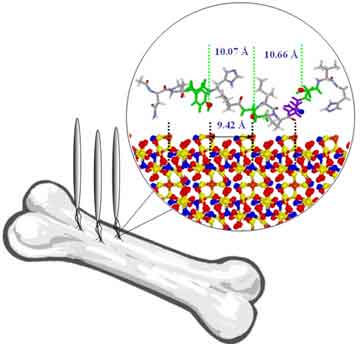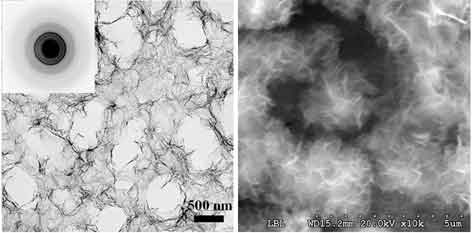
Schematic diagram of hydroxyapatite crystals and HA binding peptide. Computer simulations show the spacing of repeating hydroxyl residues of HA binding peptide are closely matched with the lattice spacing of HA crystals.
APPLICATIONS OF TECHNOLOGY:
- Bone growth promotion
- Bone growth and mineralization inhibition
- Potential osteoporosis treatment
- Cell-based treatment of bone defects
- Structural materials
ADVANTAGES:
- Collagen-mimicking oligopeptides induce mineralization
- Sequence-dependent bone mineral binding capabilities are controllable
- Peptides can be incorporated into a variety of scaffolds, injected as lipid peptide amphiphiles, or genetically expressed on osteoblasts
- Properties of the composites can be fine-tuned
DESCRIPTION:
Carolyn Bertozzi and colleagues at Berkeley Lab have identified short peptides from a library screen that can promote or inhibit mineralization depending on the scaffold and matrix that bears them. The collagen-like sequence of the peptides can be tailored to encourage varying degrees of bone mineralization. The Berkeley Lab technology introduces new approaches to orthopedics and offers flexibility not available with other techniques.
Bio-mineralization: The peptides can be used to promote mineralization of hydroxyapatite (HA), a crystalline structure that consists primarily of calcium and phosphorous and is the major inorganic mineral found in the human body. Most of the HA in our body is concentrated in bone and teeth. Thus these peptides can be used to promote bone growth. By attaching the Berkeley Lab HA-binding peptides to a synthetic scaffold, scientists are able to direct nucleation of hydroxyapatite in vitro. The peptides may also encourage the integration of implanted artificial bone with natural bone.
Another potential application of these peptides involves expression of the HA-binding peptides on osteoblasts by recombinant DNA methods. Osteoblasts genetically engineered to express the HA-binding peptides on their surface will direct mineral growth at the applied areas. This approach may be used in cell-based treatment of bone defects characterized by deficient bone growth.
Inhibition of mineralization: The Berkeley Lab peptides can also inhibit mineralization and bone growth when integrated into soluble polymer matrices. Thus HA-binding peptides may be coated onto, combined with, bound to, or integrated within a pharmaceutically acceptable delivery vehicle and injected into interspatial regions where HA deposition needs to be reduced. Other potential applications include treatment of tissue implants that require protection from hardening due to mineral deposits.
Lipid-peptide amphiphile: The HA-binding peptides can also be covalently linked to lipids to give lipid-peptide amphiphiles. They can be injected in a gel form into regions where mineralization is desired. This method potentially could be used as a minimally invasive treatment for osteoporosis. In water, the lipid-peptide amphiphiles can be self-assembled into cylindrical micelles that can form fibers with the peptide exposed at the surface. The surface peptides can then promote mineralization of these fibers. These nanostructured composites can be used in applications such as bone mimetics and other structural materials.

Electron micrographs of HA crystal formation templated by an HA-binding peptide. (A) TEM image and Selected Area Electron Diffraction (SAED) inset; (B) SEM image. The observed SAED patterns, along with the characteristic platelet crystal morphology of the minerals nucleated by HA-binding peptide, match with those of crystalline HA.
STATUS: Issued U. S. Patent 8,022,040 available at www.uspto.gov. Available for licensing or collaborative research.
REFERENCE NUMBER: IB-2080
SEE THESE OTHER BERKELEY LAB TECHNOLOGIES IN THIS FIELD: